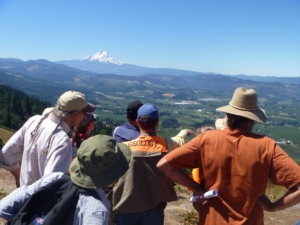We all live in a watershed.

The Hood River Watershed is a core component of every day life for the community that lives within it. This has been true since the first inhabitants of the Watershed established a village at the mouth of the Hood River. Wasco-Wishram are two closely related Chinook Indian tribes from the Columbia River, up and downstream from The Dalles. The Hood River Wasco people inhabited two village sites: Ninuhltidih on the east bank of the mouth of the Hood River, and a second site five to six miles further down the Columbia River. The Wasco people were fishermen, harvesting the abundant salmon from the Columbia and Hood Rivers. They also traded root bread, salmon meal, and bear grass with nearby tribes.
By the 1800’s, immigrants from the east began passing through the Wasco territory. In 1855, the superintendent for the Oregon Territory negotiated a series of Indian treaties including the one establishing the Warm Springs Reservation. Under the treaty, the Warm Springs and Wasco tribes relinquished approximately ten million acres of land, but reserved the Warm Springs Reservation for their exclusive use. The tribes also kept their rights to harvest fish, game, and other foods off the reservation in their usual and accustomed places (CTWS). An estimated 200 of the 4,000 enrolled tribal members of the Confederated Tribes of the Warm Springs are Wasco.
On October 29th, 1805, the Lewis and Clark Expedition “discovered” Hood River, calling it Labeasche River after one of their expedition members. Mrs. Nathaniel (Mary) Coe, a well-known early pioneer resident of the valley, was successful in encouraging the use of the name Hood River on account of Mt. Hood, the river’s source. The name Hood River appears on a map as early as 1856.
Nathaniel Coe was one of the first to plant fruit trees in the Hood River Valley. Apple orchards would flourish in the valley until 1919, when many apple trees were killed in a freeze. Apples were replaced with pear trees, and now Hood River County is one of the leading producers of Anjou pears in the world.

Today, people engage with the Watershed in countless ways. Well over 20,000 people live in and around the various communities of the Hood River Watershed, which is located entirely within Hood River County. In addition, countless visitors are drawn to the area to ski or hike the slopes of Mt. Hood, bike on forest trails, drive the Fruit Loop, and kite surf on the Columbia River at the mouth of the Hood River. Residents, workers, and visitors alike rely on the healthy ecosystems of the Watershed to provide abundant and clean water, productive agriculture, and natural beauty. Their activities, in turn, affect the health of the Watershed in various ways.
About one third of the Watershed’s population lives in the City of Hood River (US Census 2018 estimate). The remainder live in more dispersed settings on farmland, rural residential lots, and small clusters of dense development throughout the Hood River Valley. About three-quarters of the Watershed, primarily on slopes at higher elevations above the Valley, is forest and woodland and essentially unpopulated.
The communities of the Hood River Watershed support a diverse and vibrant economy with strong activity in healthcare, technology, manufacturing, professional services, agriculture, forestry, and retail trade. Farming, particularly the orchards for which the Hood River Valley is known, and recreation-oriented tourism are significant elements of the economy that stimulate broader economic activity within the community. Both farming and tourism rely on the healthy and productive natural resources of the Watershed. Manufacturing is also dominated by natural resource dependent industries such as wood products, which rely on productive forests, and an array of food and beverage businesses that depend on abundant clean water and the fruits of Hood River Valley.
The diverse community of water users in the Watershed are reflected in the make-up of Watershed Group members and supporters working to protect the health of the Watershed. Join us in our stewardship efforts.
